| UNITED STATES |
| SECURITIES AND EXCHANGE COMMISSION |
| Washington, D.C. 20549 |
FORM N-CSR |
CERTIFIED SHAREHOLDER REPORT OF REGISTERED |
MANAGEMENT INVESTMENT COMPANIES |
| Investment Company Act File Number: 811-7059 |
| T. Rowe Price Blue Chip Growth Fund, Inc. |
| (Exact name of registrant as specified in charter) |
| 100 East Pratt Street, Baltimore, MD 21202 |
| (Address of principal executive offices) |
| David Oestreicher |
| 100 East Pratt Street, Baltimore, MD 21202 |
| (Name and address of agent for service) |
| Registrant’s telephone number, including area code: (410) 345-2000 |
| Date of fiscal year end: December 31 |
| Date of reporting period: December 31, 2008 |
Item 1: Report to Shareholders
 |
| Blue Chip Growth Fund | December 31, 2008 |
The views and opinions in this report were current as of December 31, 2008. They are not guarantees of performance or investment results and should not be taken as investment advice. Investment decisions reflect a variety of factors, and the managers reserve the right to change their views about individual stocks, sectors, and the markets at any time. As a result, the views expressed should not be relied upon as a forecast of the fund’s future investment intent. The report is certified under the Sarbanes-Oxley Act, which requires mutual funds and other public companies to affirm that, to the best of their knowledge, the information in their financial reports is fairly and accurately stated in all material respects.
REPORTS ON THE WEB
Sign up for our E-mail Program, and you can begin to receive updated fund reports and prospectuses online rather than through the mail. Log in to your account at troweprice.com for more information.
Manager’s Letter
Fellow Shareholders
Global credit and financial markets suffered a traumatic decline in 2008, rivaling the major corrections of the past century. Impaired credit quality and constrained liquidity in financial markets led to a major recession and nearly unprecedented declines in global stock and bond markets. Despite intense efforts by monetary authorities, credit markets have only recently begun to show signs of improvement. Unfortunately, job losses and economic turmoil will probably persist well into 2009.
HIGHLIGHTS
• Stock markets worldwide posted steep losses for the year ended December 31, 2008, and the Blue Chip Growth Fund’s performance was hurt by the maelstrom.
• With several notable exceptions, the fund’s investments in typically defensive sectors fared best in the period.
• The investing environment could remain volatile as uncertainty about credit markets and the economy persists.
• We believe that the high-quality, consistent-growth companies that we seek to purchase are especially attractive and could perform well even if the economy only experiences a modest recovery.
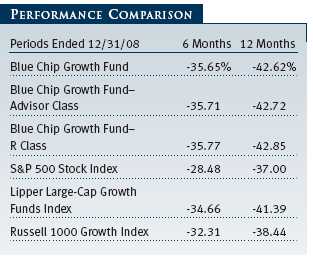
We are especially appreciative of your continued confidence in our efforts to manage your investment through this difficult period. After outperforming many of our benchmarks for certain periods (we matched or exceeded the Russell 1000 Growth Index for eight consecutive years through 2007), we underperformed in the past year. We slightly lagged the Lipper growth funds benchmark and more significantly trailed the S&P 500 Index. We understand that losses of this magnitude are painful—we are also long-term investors in the fund. Despite the equity markets’ recent disappointing performance, historical data suggest that stocks could generate very favorable returns after this type of severe correction. We have added to our stake in the fund, and we certainly appreciate your continued investment. We believe that low interest rates, valuations approaching post-World War II lows, and continued earnings growth support favorable investment performance, particularly for large-cap growth stocks.
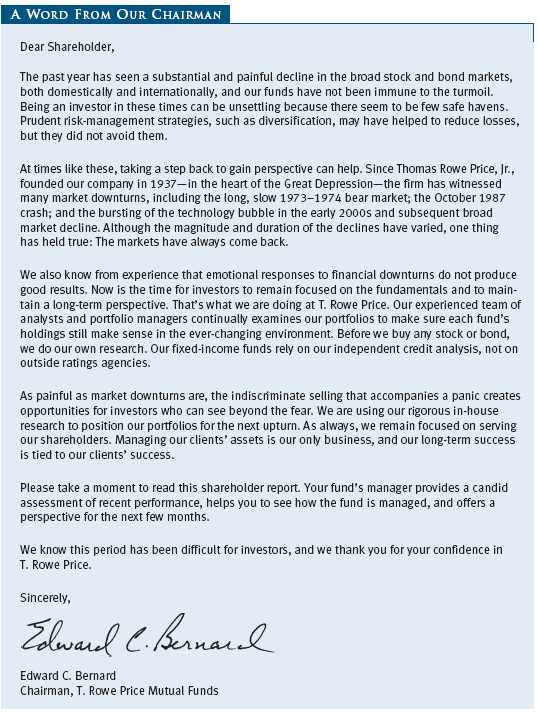
As shown in the table on page 1, the fund produced disappointing absolute and relative returns. The portfolio underperformed the S&P 500, the Lipper peer group, and its style-specific Russell benchmark for the last six and 12 months. (Results for the Advisor and R Class shares were slightly lower, reflecting their higher fee structures.) The Blue Chip Growth Fund continued to compare favorably relative to its competitors over the longer term, however. Lipper ranked the fund in the top 31% of its large-cap growth funds universe for the 10-year period ended December 31, 2008. (Based on cumulative total return, Lipper ranked the Blue Chip Growth Fund 558 out of 803, 272 out of 567, and 84 out of 274 funds in the large-cap growth funds universe for the 1-, 5-, and 10-year periods ended December 31, 2008, respectively. Past performance cannot guarantee future results.)
MARKET ENVIRONMENT
In the June 2008 letter, we wrote that “the current market environment is perhaps the most challenging we have seen in 15 years of managing your fund.” We would have been wise to pay even greater attention to our cautionary language, as many risk factors coalesced into a freezing of credit markets and ultimately a sharp contraction in business activity. Poorly structured mortgage-backed securities and a general deterioration in credit quality led to unprecedented losses for many financial companies and the outright failures or reorganizations of such household names as Lehman Brothers, Fannie Mae, Freddie Mac, and AIG. World monetary authorities injected capital directly into several financial companies and also purchased troubled or illiquid securities. The Treasury Department and Congress also intervened via the expansion of debt, deposit, and money market fund guarantees to prevent panic and foster improved liquidity and lending. Just as some of these actions began to yield modest improvements, confidence was further shaken by allegations that Bernard Madoff had defrauded investors of billions of dollars.
The effects of this stress in the financial system spread to the real economy as retail and auto sales plunged and job losses accelerated. Major U.S. auto companies faced bankruptcy without government assistance, which they received before the close of 2008. Prices of most commodities crashed, with oil plunging from over $140 per barrel to less than $40 in a few months. The resulting sharp drop in gasoline prices has provided much needed relief to consumers. Just as important, the sharp decline in economic activity and commodity prices made the objectives of monetary and fiscal policy even more clear. In December, the Federal Reserve acknowledged that the current primary risk is a severe recession and deflation and it lowered the fed funds rate to a target range of 0.00% to 0.25% while pledging to use all tools at its disposal to foster economic growth. The new Obama administration also has been emphatic that job creation and economic growth would be the first order of business and has already formulated a large fiscal stimulus package.
It will take time for the vexing problems in the financial system to dissipate even though many financial companies have already recorded huge losses and raised substantial amounts of capital. Unfortunately, there are more problems to be recognized as the credit cycle progresses. With the Democratic Party now controlling both the presidency and Congress, government policy could be much more influential in creating advantages for some industries and perhaps regulatory risks for others. Corporate earnings, inflation (as well as interest rates), and valuation will continue to be dominant determinants of stock performance. We believe that corporate earnings could continue to be solid at selected companies. Inflation and interest rates could remain quite low given the latest policy moves by the Federal Reserve. Finally, valuation is often underestimated as a factor in future stock performance. Given the sharp declines in many stocks, valuations are about as attractive as they have been in post-World War II bear markets.
The current environment poses more uncertainty and unique challenges than I have seen in my 18 years at T. Rowe Price and in my 30 years of investing. We simply do not know how effective the monetary and fiscal stimulus will be and how severe the unintended consequences (such as increased inflation) could be. In some ways, we are in uncharted territory. Of course, no one knows the answers to these questions, and every recession and business cycle presents investors with uncertainty. Each unsettled investing environment is different, with peculiar pitfalls but also tremendous opportunities.
PORTFOLIO REVIEW
Regrettably, we did not have many winning stocks in the second half of 2008. However, we did have some strong relative performers and even a few stocks that increased in value in the utilities, consumer staples, and telecommunication services sectors. One of the reasons our performance suffered is that we did not have enough significant positions in these areas. For example, we have been underweight in consumer staples for many years because we believed we could buy better defensive-growth companies in the health care sector.
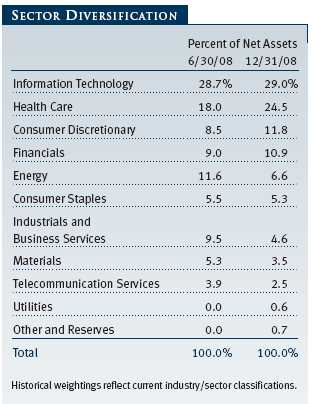
Utility holdings NRG Energy and Entergy were both positive contributors. NRG received a takeover bid from Exelon, one of the largest and highest-quality utilities in the U.S. Both Exelon and Entergy have major nuclear power operations providing a very favorable carbon footprint that should benefit under regulations anticipated under the new Obama administration. Consumer staples holdings in Procter & Gamble, Coca-Cola, and PepsiCo also performed well. We bought Coca-Cola as it declined to a reasonable valuation level before the major pullback in stock prices, and it performed admirably in the market decline. The company has shown improved product innovation and spending discipline in the last year. Our largest retail holding was Wal-Mart, which we favored over the higher-priced Target. Wal-Mart has benefited from superior execution and from customers focusing on its low-price strategy. Telecom services provider MetroPCS also performed well late in the year as its low-cost, unlimited calling plans appealed to consumers seeking value. (Please refer to the portfolio of investments for a detailed list of holdings and the amount each represents in the portfolio.)
There were also a few noteworthy winners in the consumer discretionary area. Apollo Group, a leading provider of post-secondary education services, generated solid gains. It reported outstanding results in early 2009, as many people sought to improve their educational credentials in a challenging environment. Discovery Communications, operator of several leading cable properties, such as The Learning Channel, The Food Channel, and Animal Planet, is less dependent on advertising than many media companies and continues to show strong growth and decent relative stock price performance. McDonald’s was one of only two stocks among the 30 Dow Jones Industrials components to increase in price during 2008 (the other was Wal-Mart, and we were fortunate in that we held significant positions in both). Although McDonald’s has benefited to a degree from consumers looking for value as the economy slows, it has also methodically improved restaurant operations over the past several years, offering a number of product innovations including its recent introduction of gourmet coffees.
A large investment in the biotechnology industry was also a major positive for your portfolio. Genentech, one of the oldest and largest biotech companies, received a bid from majority owner Roche to acquire the remainder of the company. Amgen and Gilead Sciences are also large positions. Their strong operating performance contributed to relatively strong stock performance in the second half of 2008.
Information technology was the fund’s worst absolute sector performer, although some of this was due to its large weighting in the portfolio. Google and Apple, very strong performers in 2007, were among our five largest detractors for the second half. Google declined as investors worried that an advertising slowdown in the paid-search area would have a profound effect on the company. While we realize the company has never been through a major recession, management is cutting expenses meaningfully, and the company’s business model and financial strength are positives in this environment. Google’s stock appreciated late in 2008 as investors became somewhat more comfortable that the company’s fundamentals are holding up reasonably well. Apple was a victim of its own success—Mac sales and the iPhone launch were so strong that investors questioned if it could continue to excel. Investors also fretted over Steve Jobs’ health and whether Apple’s long-term record of product innovation would continue. We do have concerns that sales of some products are bound to slow in this environment, but we think that the company continues to execute quite well and has tremendous management depth.
Amazon.com and Microsoft are also major technology holdings that declined significantly during the past six months. Amazon was a standout performer in 2007, and it continued to take market share and generate strong results. However, with the sharp decline in retail sales, it is reasonable that investors are concerned about the company’s growth prospects. Microsoft’s stock has been somewhat disappointing for several years but did hold up well in the recent market decline. We have described some of our frustrations in prior letters regarding its pace of product innovation and the effort to buy Yahoo!, which ultimately proved to be a costly distraction and a burden on the stock. However, we believe the company has the strengths needed to deal with the challenging environment, and management is showing much more focus on capital allocation and expense control. Our industry analyst is quite positive on the company, and we agree with the view that it can continue to generate solid growth and has a compelling valuation.
Energy was an area of colossal disappointment. Even though we cut back our energy holdings (particularly those we viewed as being more sensitive to declining oil prices), we suffered significant damage when energy prices crashed. Longtime energy services holdings Schlumberger and Smith International were our largest detractors in the sector. Both are well-run companies that have produced solid operating results and stock performance for your fund in the past. They have adapted to fluctuating energy prices over the years, but the current sharp contraction will impair growth even for these leaders. Both companies, and the entire energy segment, will have to downsize if energy demand continues to decline. Aggressive development of alternative energy forms such as solar or wind could dampen demand for oil and gas on an ongoing basis. As a result, we trimmed our weighting in Schlumberger and will be circumspect about increasing our energy allocation substantially until we are more comfortable that fundamentals in the sector have stabilized.
Financials stocks performed relatively well for your fund in 2007 and for part of 2008. Most of our holdings were not traditional banks and had limited direct credit or lending exposure. However, the intense correction in the second half of 2008 had a profound influence on capital markets. Asset managers, trust banks, and investment banks were all knocked down by the precipitous market decline. Goldman Sachs was our largest loser in financials, closely followed by State Street, Morgan Stanley, Ameriprise Financial, Franklin Resources, and Northern Trust. Each of these companies is viewed as among the strongest and best positioned in the industry, but most had noteworthy difficulties—even though they did far better than most of their competitors. Goldman received major capital investments from Warren Buffett’s Berkshire Hathaway and the U.S. Treasury. Goldman elected to be regulated as a commercial bank to improve its funding and ability to deal with significant illiquid or troubled investments. Morgan Stanley came closer to meeting the grim fate of Lehman Brothers and Bear Stearns but used its broad franchise to attract an investment from a major Japanese bank and also received capital from the U.S. government’s Troubled Asset Relief Program (TARP). Both Goldman and Morgan Stanley appear to be on much sounder footing and could generate strong growth if the environment continues to improve. In our view, the core operating performance at State Street, Franklin Resources, and Northern Trust continues to be relatively solid, but capital markets will have to improve before these companies show strong growth.
Health care was somewhat of a disappointment given our expectation that stocks in this area would perform quite defensively in a recession. While some biotech stocks and other selected stocks were solid performers, device makers, such as Medtronic, Stryker, and St. Jude Medical, generated disappointing performance. Consumers began to defer some medical procedures and hospitals cut their budgets in response to the financial crisis. The strengthening dollar relative to some foreign currencies also created a headwind for several health care companies. While we think these factors are legitimate concerns and have trimmed certain holdings as a result, we continue to believe that health care is one of the most attractive sectors in terms of being able to buy consistent-growth companies at reasonable valuations.
STRATEGY
Additions to holdings such as Amgen, Apple, Amazon, and McGraw-Hill were significant enough to be included in the 10 largest purchases for the past six months. We also initiated several new positions. We have been underweight in financials and extremely underweight in the banking industry and used the recent weakness to slowly increase our exposure. Wells Fargo is a leading U.S. bank with better credit quality than most and has an excellent record of generating more revenue per customer than competitors. The company was recently able to acquire Wachovia at what we believe will prove to be a very attractive price. This thought process also drove our decision to purchase JPMorgan Chase. The firm was a standout in this downturn with superior underwriting and balance sheet strength. It also was involved in several acquisitions, such as the purchase of Washington Mutual, which should be quite beneficial over time. We purchased Research in Motion, the maker of the BlackBerry Storm and Bold smart phones and other communications devices, after the stock declined dramatically. While there are certainly risks involved with this investment—job losses hurt demand for BlackBerrys and margins on some new products like the Storm and Bold are compressed—sales are quite strong. Nike is a very profitable, high-quality company with a strong balance sheet. When the stock declined sharply, we purchased this company, which we have followed carefully over time. As previously noted, Apollo is the leading provider of for-profit post-secondary education services. We purchased it early in the second half of 2008, and the company has generated strong operating results (as workers seek to improve educational credentials) and solid stock performance since the purchase. Wynn Resorts is the best-positioned gaming company in the world, in our view. We had been fortunate enough to sell our position at much higher prices (sold at an average of almost $130), and we are now slowly rebuilding the position. We recognize that the environment is difficult, but Wynn has a strong balance sheet and high-quality properties.
Our largest sales included the elimination of Freeport-McMoRan Copper & Gold. We sold this stock at prices that were much higher than current levels (although we still lost a significant amount of money on the investment). This sale is an example of where we had to face up to the fact that the environment was much more difficult than we had projected. We had been wary of making a large investment in commodities of any type but believed that copper and potash were two materials where the supply was either controlled or difficult to increase rapidly in response to improving demand. Several other substantial sales were driven by stocks performing well and approaching price targets. For example, Automatic Data Processing did well on a relative basis. Even though it is a high-quality company, sharply rising unemployment and rapidly declining interest rates (which hurts its margins on interest income) will reduce its growth, so we sold part of our position. Other sales, such as our sharp reduction in Baker Hughes, were made earlier in the period at higher prices because we felt that robust energy prices might decline sharply and other energy service names were also producing relatively better results.
OUTLOOK
Impaired credit quality and constrained liquidity in financial markets have led to a major recession and nearly unprecedented declines in global stock and bond markets. One would have to go back to 1939 to find a 10-year period with poorer stock price performance. The monetary and fiscal stimulus, which central banks and governments are currently applying, will certainly play a key role in improving financial markets and underlying economies. However, the pace and effectiveness of the improvement and also the extent of unintended consequences such as inflation are quite difficult to discern. We must acknowledge that we have no special insight as to how these issues will unfold. We also humbly note that much of the healing will take time and require natural economic forces to play out. Stimulus programs can be helpful, but private enterprise and time ultimately are required to bring about lasting prosperity.
Coming off a year like 2008, we are especially mindful of the frailties of human predictive powers (including ours). We have always strived to avoid creating false optimism or expectations for improvement in the environment or stock market that can set up investors for disappointment. Given the many uncertainties in the environment, we certainly want to be careful to make a balanced assessment now. We strive to be realists. In our view, it is especially important for investors to be realists—they must try to see things as they are, not as they wish them to be.
Despite the uncertainty surrounding how effective fiscal and monetary actions will be in healing the economy, there are several factors working in our favor:
1. Stocks historically have performed quite well following a one-year debacle, such as the one we have just experienced, and also especially well following a poor 10-year period of stock performance. Essentially, we have experienced two major bear markets in the past 10 years.
2. Stock valuations are quite attractive, especially in relation to the extremely low level of interest rates. Current valuations are similar to those seen at the bottom of the worst bear markets since World War II. The spread between the earnings yield on stocks and the 10-year Treasury rate is attractive in any historical context.
3. We believe that the high-quality, consistent-growth companies that we seek to purchase are especially attractive and could conceivably perform well even if the economy experiences only a modest recovery.
4. Many large-cap growth companies have solid balance sheets with record amounts of cash and strong capital bases. This should allow them to withstand challenges and also be opportunistic in investing in products or acquiring other businesses as change creates dislocation.
5. Many of our holdings generate significant free cash flow. Shareholder-oriented managements can use this cash to pay dividends (which receive more favorable tax treatment than they did a few years ago), repurchase shares, or make value-added acquisitions.
We continue to strive to enhance returns in a difficult environment by investing in quality companies with durable, sustainable earnings and cash flow growth. We appreciate your continued confidence in this endeavor.
Respectfully submitted,

Larry J. Puglia
President and chairman of the Investment Advisory Committee
January 14, 2009
The committee chairman has day-to-day responsibility for managing the portfolio and works with committee members in developing and executing the fund’s investment program.
RISKS OF STOCK INVESTING
The fund’s share price can fall because of weakness in the stock markets, a particular industry, or specific holdings. Stock markets can decline for many reasons, including adverse political or economic developments, changes in investor psychology, or heavy institutional selling. The prospects for an industry or company may deteriorate because of a variety of factors, including disappointing earnings or changes in the competitive environment. In addition, the investment manager’s assessment of companies held in a fund may prove incorrect, resulting in losses or poor performance even in rising markets. Growth stocks can be volatile because these companies usually invest a high portion of earnings in their businesses, and earnings disappointments often lead to sharply falling prices. The value approach carries the risk that a security’s intrinsic value may not be recognized for a long time or that the stock may actually be appropriately priced.
GLOSSARY
Dividend yield: The annual dividend of a stock divided by the stock’s price.
Free cash flow: The excess cash a company is generating from its operations that can be taken out of the business for the benefit of shareholders, such as dividends, share repurchases, investments, and acquisitions.
Lipper indexes: Fund benchmarks that consist of a small number (10 to 30) of the largest mutual funds in a particular category as tracked by Lipper Inc.
Price/book ratio: A valuation measure that compares a stock’s market price to its book value, i.e., the company’s net worth divided by the number of outstanding shares.
Price/earnings ratio (P/E): A valuation measure calculated by dividing the price of a stock by its current or projected earnings per share. This ratio gives investors an idea of how much they are paying for current or future earnings power.
Russell 1000 Growth Index: Market capitalization-weighted index of those firms in the Russell 1000 with higher price-to-book ratios and higher forecasted growth values.
S&P 500 Stock Index: An unmanaged index that tracks the stocks of 500 primarily large-cap U.S. companies.
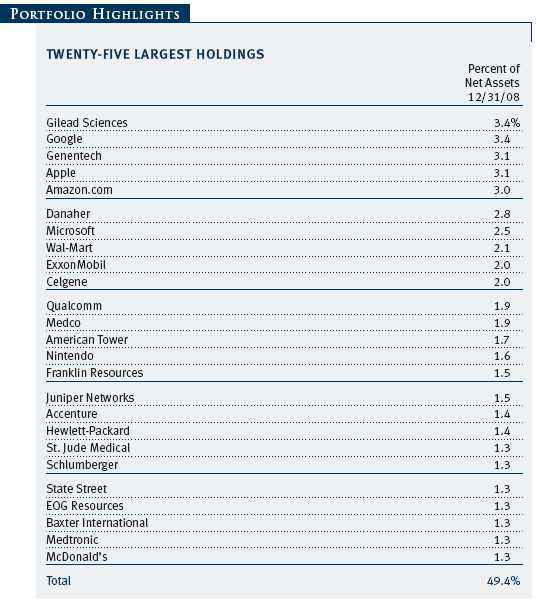
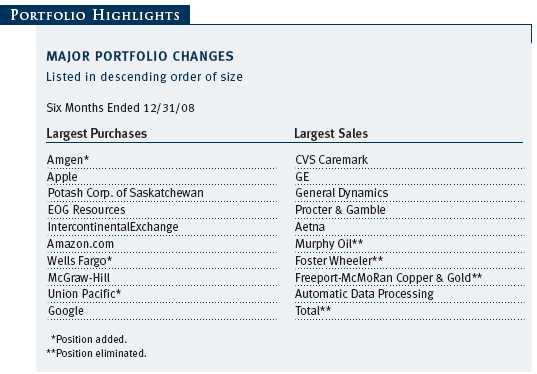
Performance and Expenses
| GROWTH OF $10,000 |
This chart shows the value of a hypothetical $10,000 investment in the fund over the past 10 fiscal year periods or since inception (for funds lacking 10-year records). The result is compared with benchmarks, which may include a broad-based market index and a peer group average or index. Market indexes do not include expenses, which are deducted from fund returns as well as mutual fund averages and indexes.
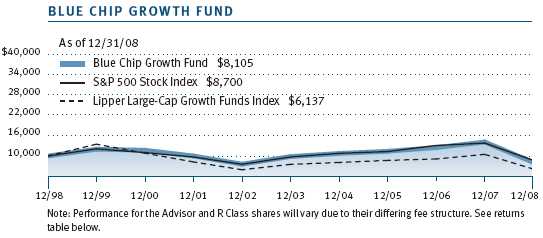
| AVERAGE ANNUAL COMPOUND TOTAL RETURN |
This table shows how the fund would have performed each year if its actual (or cumulative) returns had been earned at a constant rate.
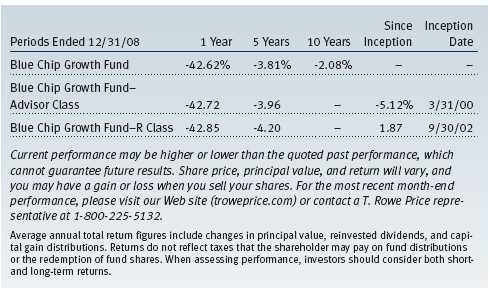

| FUND EXPENSE EXAMPLE |
As a mutual fund shareholder, you may incur two types of costs: (1) transaction costs, such as redemption fees or sales loads, and (2) ongoing costs, including management fees, distribution and service (12b-1) fees, and other fund expenses. The following example is intended to help you understand your ongoing costs (in dollars) of investing in the fund and to compare these costs with the ongoing costs of investing in other mutual funds. The example is based on an investment of $1,000 invested at the beginning of the most recent six-month period and held for the entire period.
Please note that the fund has three share classes: The original share class (“investor class”) charges no distribution and service (12b-1) fee; Advisor Class shares are offered only through unaffiliated brokers and other financial intermediaries and charge a 0.25% 12b-1 fee; and R Class shares are available to retirement plans serviced by intermediaries and charge a 0.50% 12b-1 fee. Each share class is presented separately in the table.
Actual Expenses
The first line of the following table (“Actual”) provides information about actual account values and expenses based on the fund’s actual returns. You may use the information in this line, together with your account balance, to estimate the expenses that you paid over the period. Simply divide your account value by $1,000 (for example, an $8,600 account value divided by $1,000 = 8.6), then multiply the result by the number in the first line under the heading “Expenses Paid During Period” to estimate the expenses you paid on your account during this period.
Hypothetical Example for Comparison Purposes
The information on the second line of the table (“Hypothetical”) is based on hypothetical account values and expenses derived from the fund’s actual expense ratio and an assumed 5% per year rate of return before expenses (not the fund’s actual return). You may compare the ongoing costs of investing in the fund with other funds by contrasting this 5% hypothetical example and the 5% hypothetical examples that appear in the shareholder reports of the other funds. The hypothetical account values and expenses may not be used to estimate the actual ending account balance or expenses you paid for the period.
Note: T. Rowe Price charges an annual small-account maintenance fee of $10, generally for accounts with less than $2,000 ($500 for UGMA/UTMA). The fee is waived for any investor whose T. Rowe Price mutual fund accounts total $25,000 or more, accounts employing automatic investing, and IRAs and other retirement plan accounts that utilize a prototype plan sponsored by T. Rowe Price (although a separate custodial or administrative fee may apply to such accounts). This fee is not included in the accompanying table. If you are subject to the fee, keep it in mind when you are estimating the ongoing expenses of investing in the fund and when comparing the expenses of this fund with other funds.
You should also be aware that the expenses shown in the table highlight only your ongoing costs and do not reflect any transaction costs, such as redemption fees or sales loads. Therefore, the second line of the table is useful in comparing ongoing costs only and will not help you determine the relative total costs of owning different funds. To the extent a fund charges transaction costs, however, the total cost of owning that fund is higher.
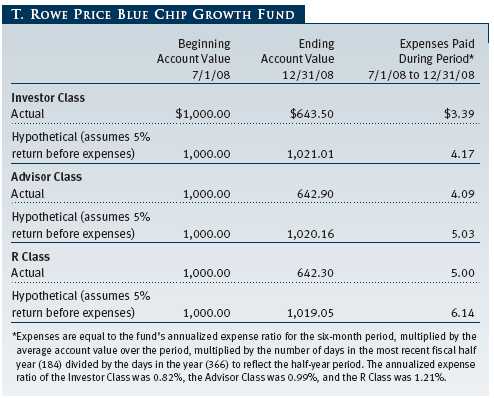
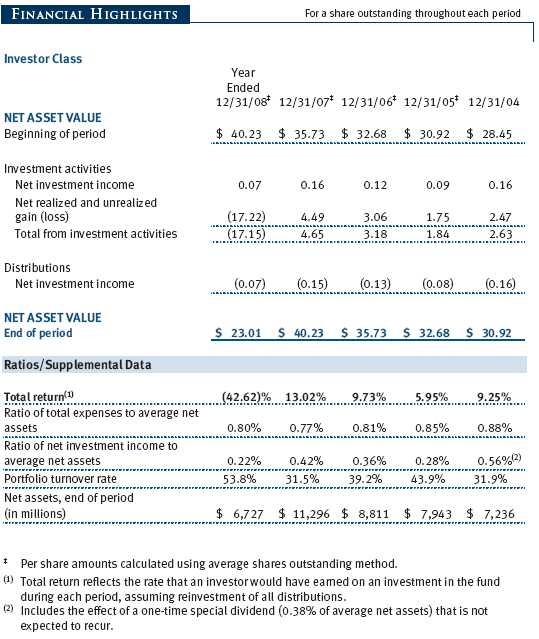
The accompanying notes are an integral part of these financial statements.
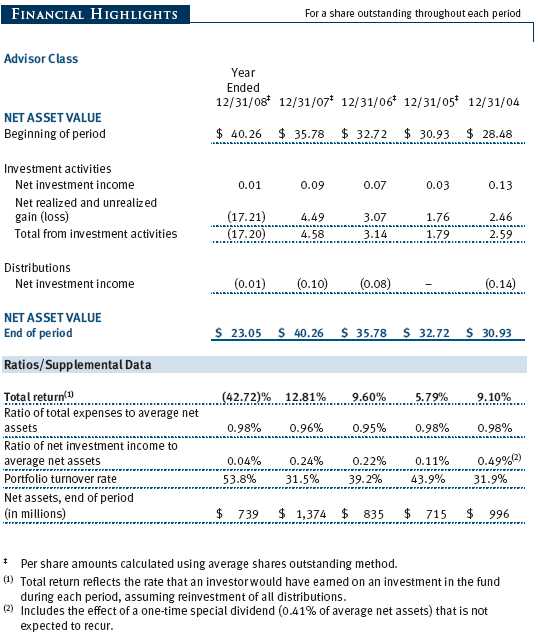
The accompanying notes are an integral part of these financial statements.
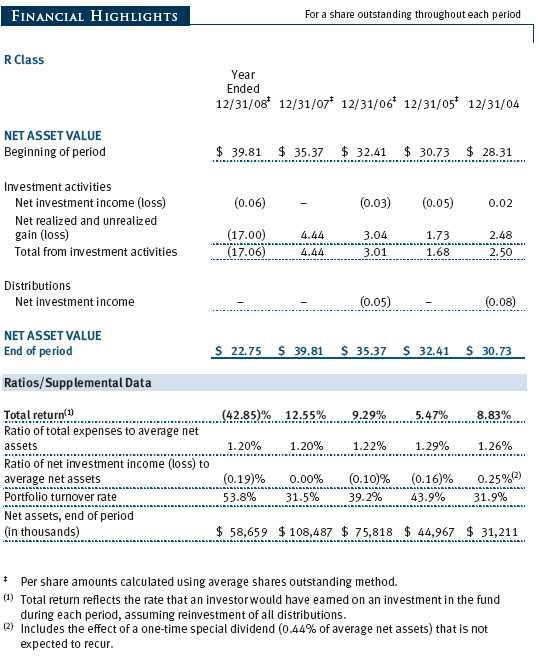
The accompanying notes are an integral part of these financial statements.
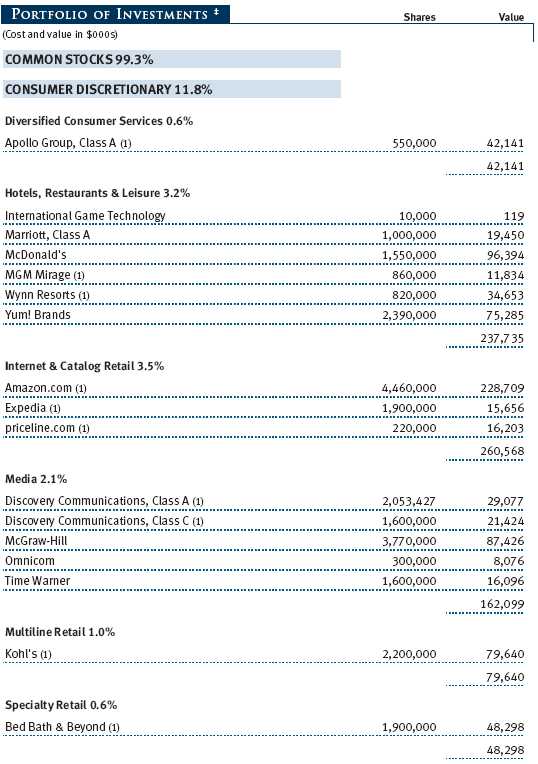
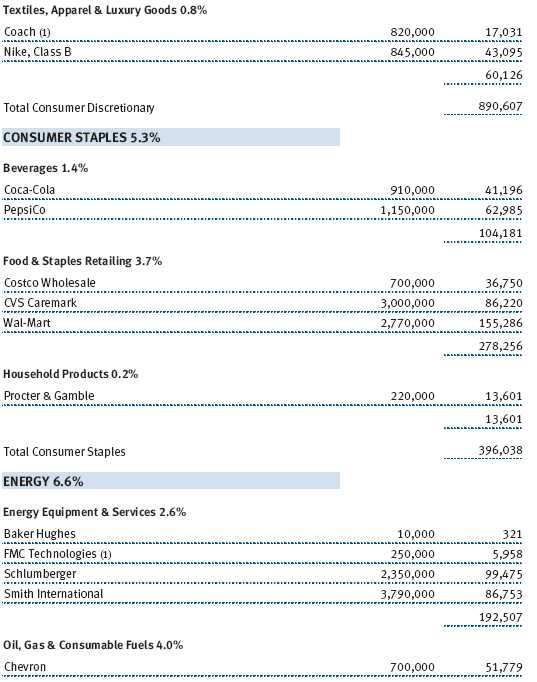
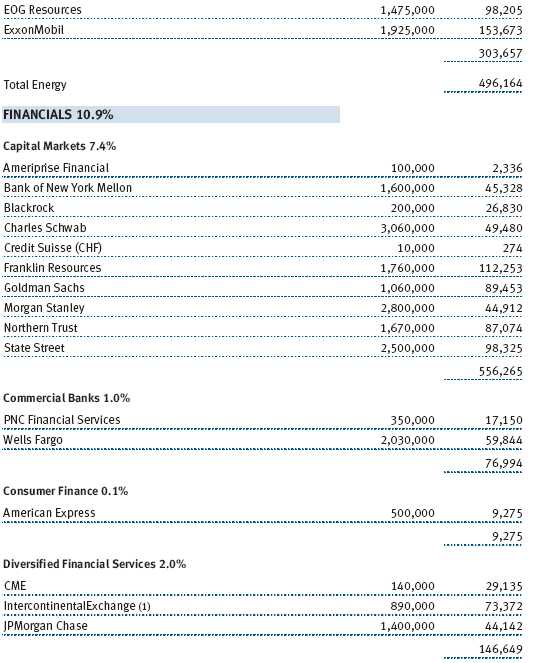
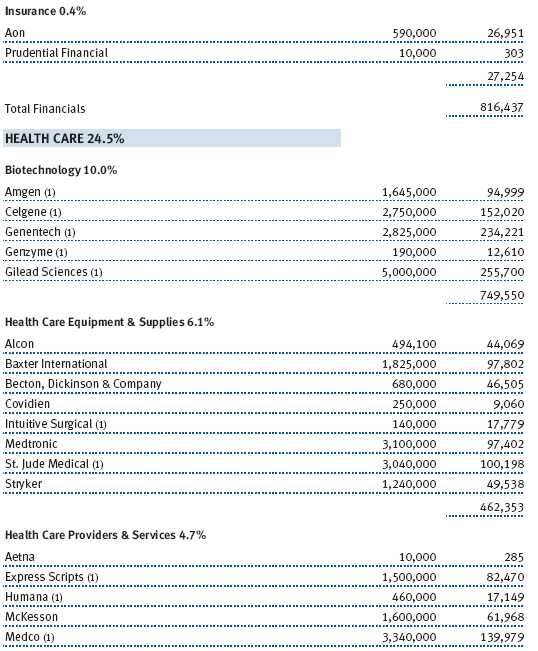
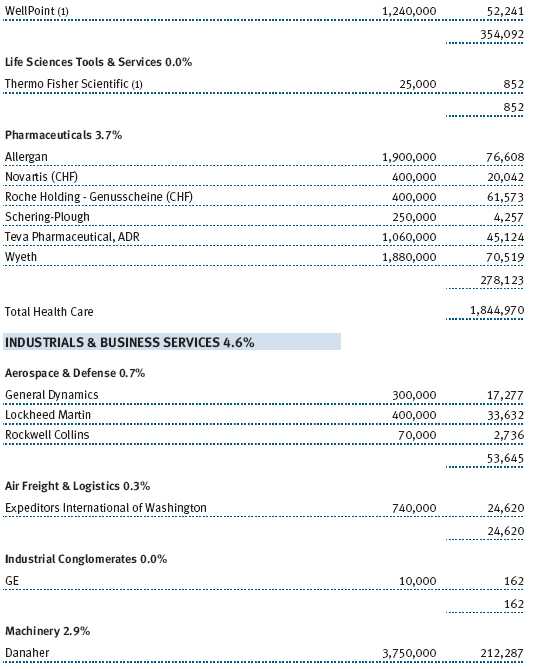
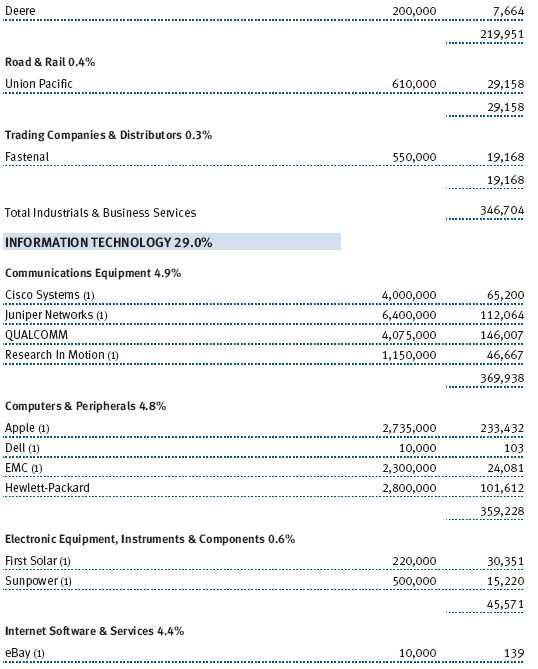
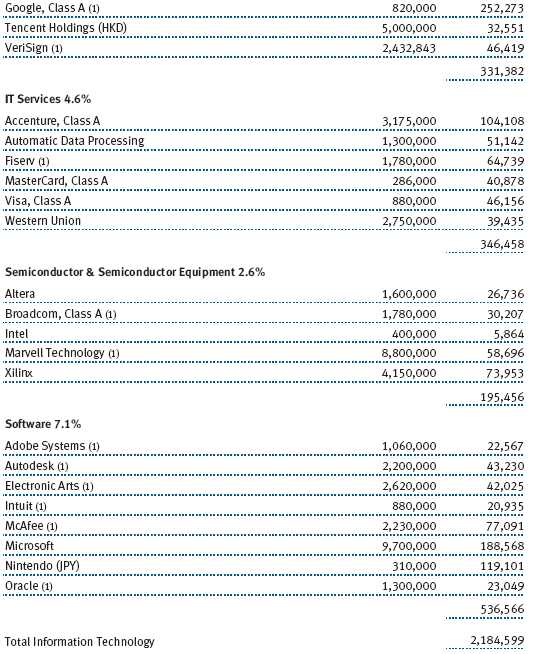
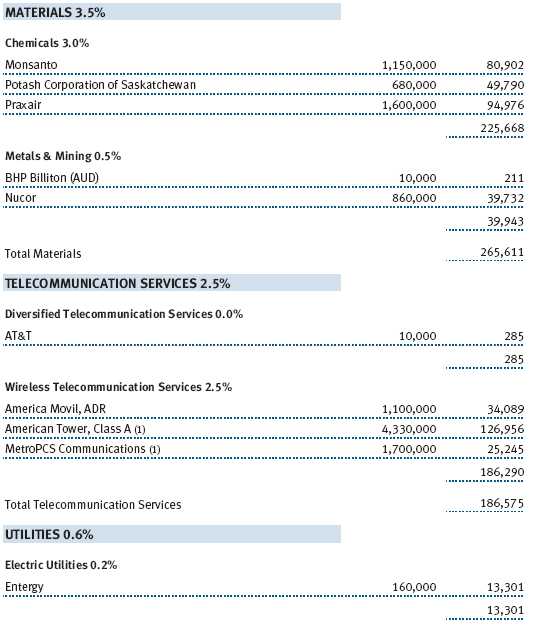
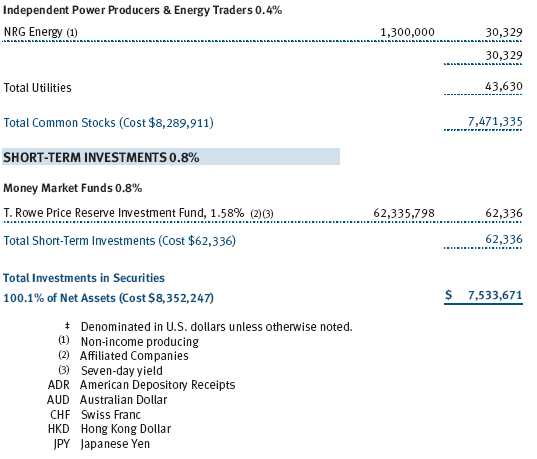
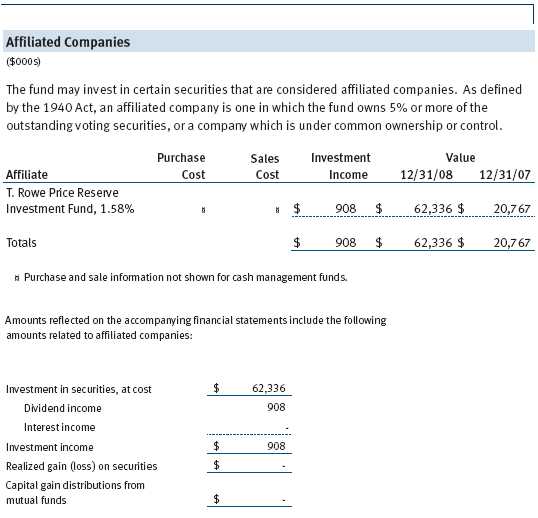
The accompanying notes are an integral part of these financial statements.
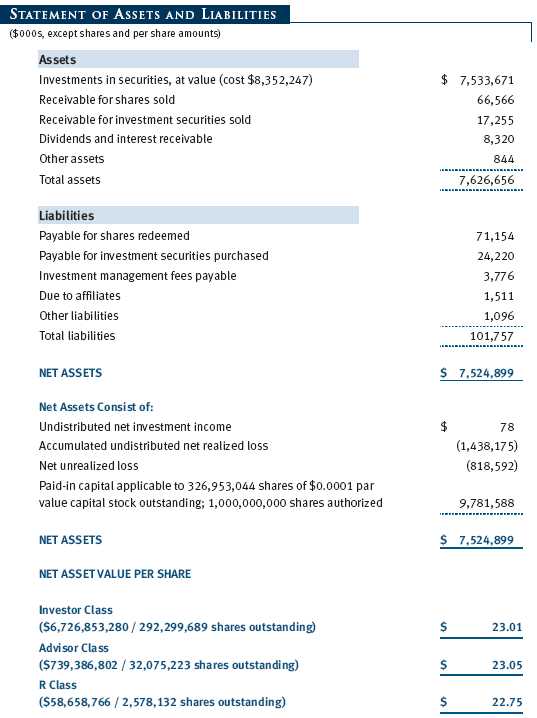
The accompanying notes are an integral part of these financial statements.
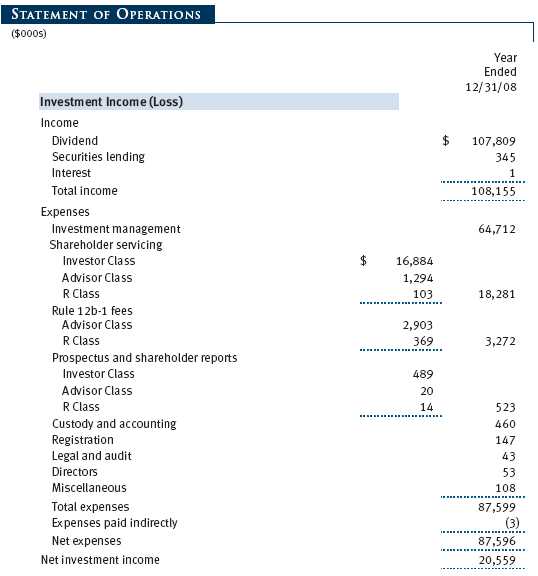
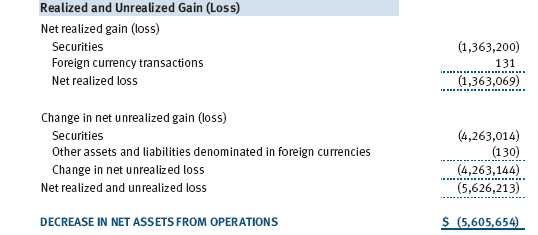
The accompanying notes are an integral part of these financial statements.
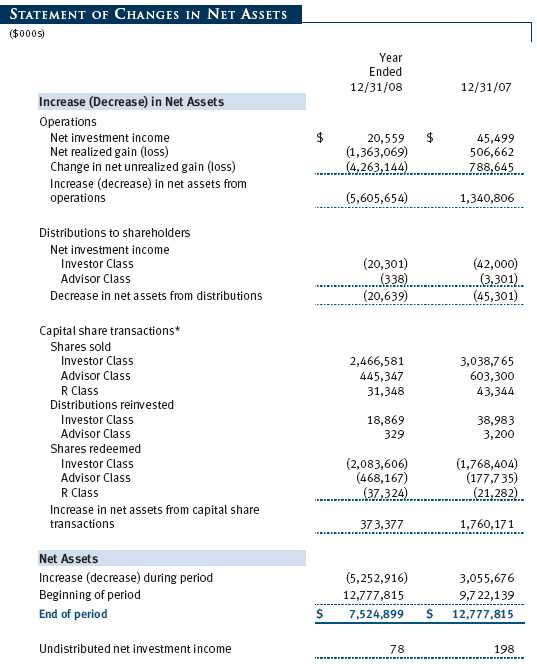

The accompanying notes are an integral part of these financial statements.
| NOTES TO FINANCIAL STATEMENTS |
T. Rowe Price Blue Chip Growth Fund, Inc. (the fund), is registered under the Investment Company Act of 1940 (the 1940 Act) as a diversified, open-end management investment company. The fund seeks to provide long-term capital growth. Income is a secondary objective. The fund has three classes of shares: the Blue Chip Growth Fund original share class, referred to in this report as the Investor Class, offered since June 30, 1993; the Blue Chip Growth Fund—Advisor Class (Advisor Class), offered since March 31, 2000; and the Blue Chip Growth Fund—R Class (R Class), offered since September 30, 2002. Advisor Class shares are sold only through unaffiliated brokers and other unaffiliated financial intermediaries, and R Class shares are available to retirement plans serviced by intermediaries. The Advisor Class and R Class each operate under separate Board-approved Rule 12b-1 plans, pursuant to which each class compensates financial intermediaries for distribution, shareholder servicing, and/or certain administrative services. Each class has exclusive voting rights on matters related solely to that class, separate voting rights on matters that relate to all classes, and, in all other respects, the same rights and obligations as the other classes.
NOTE 1 - SIGNIFICANT ACCOUNTING POLICIES
Basis of Preparation The accompanying financial statements were prepared in accordance with accounting principles generally accepted in the United States of America, which require the use of estimates made by fund management. Fund management believes that estimates and security valuations are appropriate; however, actual results may differ from those estimates, and the security valuations reflected in the financial statements may differ from the value the fund ultimately realizes upon sale of the securities.
Investment Transactions, Investment Income, and Distributions Income and expenses are recorded on the accrual basis. Dividends received from mutual fund investments are reflected as dividend income; capital gain distributions are reflected as realized gain/loss. Dividend income and capital gain distributions are recorded on the ex-dividend date. Income tax-related interest and penalties, if incurred, would be recorded as income tax expense. Investment transactions are accounted for on the trade date. Realized gains and losses are reported on the identified cost basis. Distributions to shareholders are recorded on the ex-dividend date. Income distributions are declared and paid by each class on an annual basis. Capital gain distributions, if any, are declared and paid by the fund, typically on an annual basis.
Currency Translation Assets, including investments, and liabilities denominated in foreign currencies are translated into U.S. dollar values each day at the prevailing exchange rate, using the mean of the bid and asked prices of such currencies against U.S. dollars as quoted by a major bank. Purchases and sales of securities, income, and expenses are translated into U.S. dollars at the prevailing exchange rate on the date of the transaction. The effect of changes in foreign currency exchange rates on realized and unrealized security gains and losses is reflected as a component of security gains and losses.
Class Accounting The Advisor Class and R Class each pay distribution, shareholder servicing, and/or certain administrative expenses in the form of Rule 12b-1 fees, in an amount not exceeding 0.25% and 0.50%, respectively, of the class’s average daily net assets. Shareholder servicing, prospectus, and shareholder report expenses incurred by each class are charged directly to the class to which they relate. Expenses common to all classes, investment income, and realized and unrealized gains and losses are allocated to the classes based upon the relative daily net assets of each class.
Rebates and Credits Subject to best execution, the fund may direct certain security trades to brokers who have agreed to rebate a portion of the related brokerage commission to the fund in cash. Commission rebates are reflected as realized gain on securities in the accompanying financial statements and totaled $346,000 for the year ended December 31, 2008. Additionally, the fund earns credits on temporarily uninvested cash balances at the custodian that reduce the fund’s custody charges. Custody expense in the accompanying financial statements is presented before reduction for credits, which are reflected as expenses paid indirectly.
New Accounting Pronouncements On January 1, 2008, the fund adopted Statement of Financial Accounting Standards No. 157 (FAS 157), Fair Value Measurements. FAS 157 defines fair value, establishes the framework for measuring fair value, and expands the disclosures of fair value measurements in the financial statements. Adoption of FAS 157 did not have a material impact on the fund’s net assets or results of operations.
In March 2008, the Financial Accounting Standards Board issued Statement of Financial Accounting Standards No. 161 (FAS 161), Disclosures about Derivative Instruments and Hedging Activities, which is effective for fiscal years and interim periods beginning after November 15, 2008. FAS 161 requires enhanced disclosures about derivative and hedging activities, including how such activities are accounted for and their effect on financial position, performance and cash flows. Management is currently evaluating the impact the adoption of FAS 161 will have on the fund’s financial statements and related disclosures.
NOTE 2 - VALUATION
The fund’s investments are reported at fair value as defined under FAS 157. The fund values its investments and computes its net asset value per share at the close of the New York Stock Exchange (NYSE), normally 4 p.m. ET, each day that the NYSE is open for business.
Valuation Methods Equity securities listed or regularly traded on a securities exchange or in the over-the-counter (OTC) market are valued at the last quoted sale price or, for certain markets, the official closing price at the time the valuations are made, except for OTC Bulletin Board securities, which are valued at the mean of the latest bid and asked prices. A security that is listed or traded on more than one exchange is valued at the quotation on the exchange determined to be the primary market for such security. Listed securities not traded on a particular day are valued at the mean of the latest bid and asked prices for domestic securities and the last quoted sale price for international securities.
Investments in mutual funds are valued at the mutual fund’s closing net asset value per share on the day of valuation.
Other investments, including restricted securities, and those for which the above valuation procedures are inappropriate or are deemed not to reflect fair value are stated at fair value as determined in good faith by the T. Rowe Price Valuation Committee, established by the fund’s Board of Directors.
For valuation purposes, the last quoted prices of non-U.S. equity securities may be adjusted under the circumstances described below. If the fund determines that developments between the close of a foreign market and the close of the NYSE will, in its judgment, materially affect the value of some or all of its portfolio securities, the fund will adjust the previous closing prices to reflect what it believes to be the fair value of the securities as of the close of the NYSE. In deciding whether it is necessary to adjust closing prices to reflect fair value, the fund reviews a variety of factors, including developments in foreign markets, the performance of U.S. securities markets, and the performance of instruments trading in U.S. markets that represent foreign securities and baskets of foreign securities. A fund may also fair value securities in other situations, such as when a particular foreign market is closed but the fund is open. The fund uses outside pricing services to provide it with closing prices and information to evaluate and/or adjust those prices. The fund cannot predict how often it will use closing prices and how often it will determine it necessary to adjust those prices to reflect fair value. As a means of evaluating its security valuation process, the fund routinely compares closing prices, the next day’s opening prices in the same markets, and adjusted prices.
Valuation Inputs Various inputs are used to determine the value of the fund’s investments. These inputs are summarized in the three broad levels listed below:
Level 1 – quoted prices in active markets for identical securities
Level 2 – observable inputs other than Level 1 quoted prices (including, but not limited to, quoted prices for similar securities, interest rates, prepayment speeds, credit risk)
Level 3 – unobservable inputs
Observable inputs are those based on market data obtained from sources independent of the fund, and unobservable inputs reflect the fund’s own assumptions based on the best information available. The input levels are not necessarily an indication of the risk or liquidity associated with investments at that level. For example, non-U.S. equity securities actively traded in foreign markets generally are reflected in Level 2 despite the availability of closing prices, because the fund evaluates and determines whether those closing prices reflect fair value at the close of the NYSE or require adjustment, as described above. The following table summarizes the fund’s investments, based on the inputs used to determine their values on December 31, 2008:

NOTE 3 - INVESTMENT TRANSACTIONS
Consistent with its investment objective, the fund engages in the following practices to manage exposure to certain risks or to enhance performance. The investment objective, policies, program, and risk factors of the fund are described more fully in the fund’s prospectus and Statement of Additional Information.
Securities Lending The fund lends its securities to approved brokers to earn additional income. It receives as collateral cash and U.S. government securities valued at 102% to 105% of the value of the securities on loan. Cash collateral is invested by the fund’s lending agent(s) in accordance with investment guidelines approved by fund management. Although risk is mitigated by the collateral, the fund could experience a delay in recovering its securities and a possible loss of income or value if the borrower fails to return the securities or if collateral investments decline in value. Securities lending revenue recognized by the fund consists of earnings on invested collateral and borrowing fees, net of any rebates to the borrower and compensation to the lending agent. At December 31, 2008, there were no securities on loan.
Other Purchases and sales of portfolio securities, other than short-term securities, aggregated $6,161,143,000 and $5,779,913,000, respectively, for the year ended December 31, 2008.
NOTE 4 - FEDERAL INCOME TAXES
No provision for federal income taxes is required since the fund intends to continue to qualify as a regulated investment company under Subchapter M of the Internal Revenue Code and distribute to shareholders all of its taxable income and gains. Distributions are determined in accordance with Federal income tax regulations, which differ from generally accepted accounting principles, and, therefore, may differ significantly in amount or character from net investment income and realized gains for financial reporting purposes. Financial reporting records are adjusted for permanent book/tax differences to reflect tax character but are not adjusted for temporary differences.
Reclassifications between income and gain relate primarily to the character of foreign capital gain taxes. For the year ended December 31, 2008, the following reclassifications, which had no impact on results of operations or net assets, were recorded to reflect tax character:

Distributions during the years ended December 31, 2008 and December 31, 2007, totaled $20,639,000 and $45,301,000, respectively, and were characterized as ordinary. At December 31, 2008, the tax-basis cost of investments and components of net assets were as follows:
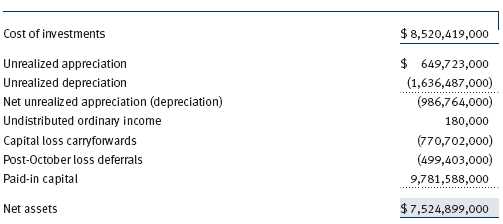
The difference between book-basis and tax-basis net unrealized appreciation (depreciation) is attributable to the deferral of losses from wash sales for tax purposes.
The fund intends to retain realized gains to the extent of available capital loss carryforwards. As of December 31, 2008, unused capital loss carryforwards expire as follows: $74,856,000 in fiscal 2011, and $695,846,000 in fiscal 2016. Pursuant to federal income tax regulations applicable to investment companies, recognition of capital losses on certain transactions is deferred until the subsequent tax year. Consequently, realized losses reflected in the accompanying financial statements include net capital losses realized between November 1 and the fund’s fiscal year-end that have not been recognized for tax purposes (Post-October loss deferrals).
NOTE 5 - RELATED PARTY TRANSACTIONS
The fund is managed by T. Rowe Price Associates, Inc. (the manager or Price Associates), a wholly owned subsidiary of T. Rowe Price Group, Inc. The investment management agreement between the fund and the manager provides for an annual investment management fee, which is computed daily and paid monthly. The fee consists of an individual fund fee and a group fee. The individual fund fee is equal to 0.30% of the fund’s average daily net assets up to $15 billion and 0.255% of the fund’s average daily net assets in excess of $15 billion. The group fee rate is calculated based on the combined net assets of certain mutual funds sponsored by Price Associates (the group) applied to a graduated fee schedule, with rates ranging from 0.48% for the first $1 billion of assets to 0.285% for assets in excess of $220 billion. The fund’s group fee is determined by applying the group fee rate to the fund’s average daily net assets. At December 31, 2008, the effective annual group fee rate was 0.31%.
In addition, the fund has entered into service agreements with Price Associates and two wholly owned subsidiaries of Price Associates (collectively, Price). Price Associates computes the daily share prices and provides certain other administrative services to the fund. T. Rowe Price Services, Inc., provides shareholder and administrative services in its capacity as the fund’s transfer and dividend disbursing agent. T. Rowe Price Retirement Plan Services, Inc., provides subaccounting and recordkeeping services for certain retirement accounts invested in the Investor Class and R Class. For the year ended December 31, 2008, expenses incurred pursuant to these service agreements were $135,000 for Price Associates, $4,157,000 for T. Rowe Price Services, Inc., and $6,546,000 for T. Rowe Price Retirement Plan Services, Inc. The total amount payable at period-end pursuant to these service agreements is reflected as Due to Affiliates in the accompanying financial statements.
Additionally, the fund is one of several mutual funds in which certain college savings plans managed by Price Associates may invest. As approved by the fund’s Board of Directors, shareholder servicing costs associated with each college savings plan are borne by the fund in proportion to the average daily value of its shares owned by the college savings plan. For the year ended December 31, 2008, the fund was charged $1,063,000 for shareholder servicing costs related to the college savings plans, of which $883,000 was for services provided by Price. The amount payable at period-end pursuant to this agreement is reflected as Due to Affiliates in the accompanying financial statements. At December 31, 2008, approximately 5% of the outstanding shares of the Investor Class were held by college savings plans.
The fund is also one of several mutual funds sponsored by Price Associates (underlying Price funds) in which the T. Rowe Price Spectrum Funds (Spectrum Funds) may invest. The Spectrum Funds do not invest in the underlying Price funds for the purpose of exercising management or control. Pursuant to a special servicing agreement, expenses associated with the operation of the Spectrum Funds are borne by each underlying Price fund to the extent of estimated savings to it and in proportion to the average daily value of its shares owned by the Spectrum Funds. Expenses allocated under this agreement are reflected as shareholder servicing expense in the accompanying financial statements. For the year ended December 31, 2008, the fund was allocated $928,000 of Spectrum Funds’ expenses, of which $672,000 related to services provided by Price. The amount payable at period-end pursuant to this agreement is reflected as Due to Affiliates in the accompanying financial statements. At December 31, 2008, approximately 6% of the outstanding shares of the Investor Class were held by the Spectrum Funds.
The fund may invest in the T. Rowe Price Reserve Investment Fund and the T. Rowe Price Government Reserve Investment Fund (collectively, the T. Rowe Price Reserve Investment Funds), open-end management investment companies managed by Price Associates and considered affiliates of the fund. The T. Rowe Price Reserve Investment Funds are offered as cash management options to mutual funds, trusts, and other accounts managed by Price Associates and/or its affiliates and are not available for direct purchase by members of the public. The T. Rowe Price Reserve Investment Funds pay no investment management fees.
NOTE 6 - INTERFUND BORROWING PROGRAM
Pursuant to its prospectus, the fund may borrow up to 33 1/3% of its total assets. The manager has developed a program that provides temporary liquidity under an interfund borrowing agreement between the fund and other T. Rowe Price-sponsored mutual funds and permits the borrowing and lending of cash at rates beneficial to both the borrowing and lending funds. Pursuant to program guidelines, loans totaling 10% or more of a borrowing fund’s total assets are collateralized at 102% of the value of the loan; loans of less than 10% are unsecured. During the year ended December 31, 2008, the fund incurred $39,000 in interest expense related to outstanding borrowings on 44 days, in the average amount of $12,311,000, and at an average annual rate of 2.64%. At December 31, 2008, there were no borrowings outstanding.
| REPORT OF INDEPENDENT REGISTERED PUBLIC ACCOUNTING FIRM |
To the Board of Directors and Shareholders of T. Rowe Price Blue Chip Growth Fund, Inc.
In our opinion, the accompanying statement of assets and liabilities, including the schedule of investments, and the related statements of operations and of changes in net assets and the financial highlights present fairly, in all material respects, the financial position of T. Rowe Price Blue Chip Growth Fund, Inc. (the “Fund”) at December 31, 2008, the results of its operations for the year then ended, the changes in its net assets for each of the two years in the period then ended and the financial highlights for each of the five years in the period then ended, in conformity with accounting principles generally accepted in the United States of America. These financial statements and financial highlights (hereafter referred to as “financial statements”) are the responsibility of the Fund’s management; our responsibility is to express an opinion on these financial statements based on our audits. We conducted our audits of these financial statements in accordance with the standards of the Public Company Accounting Oversight Board (United States). Those standards require that we plan and perform the audit to obtain reasonable assurance about whether the financial statements are free of material misstatement. An audit includes examining, on a test basis, evidence supporting the amounts and disclosures in the financial statements, assessing the accounting principles used and significant estimates made by management, and evaluating the overall financial statement presentation. We believe that our audits, which included confirmation of securities at December 31, 2008 by correspondence with the custodian and confirmation of the underlying fund by correspondence with the transfer agent, provide a reasonable basis for our opinion.
PricewaterhouseCoopers LLP
Baltimore, Maryland
February 12, 2009
| TAX INFORMATION (UNAUDITED) FOR THE TAX YEAR ENDED 12/31/08 |
We are providing this information as required by the Internal Revenue Code. The amounts shown may differ from those elsewhere in this report because of differences between tax and financial reporting requirements.
For taxable non-corporate shareholders, $20,603,000 of the fund’s income represents qualified dividend income subject to the 15% rate category.
For corporate shareholders, $20,603,000 of the fund’s income qualifies for the dividends-received deduction.
| INFORMATION ON PROXY VOTING POLICIES, PROCEDURES, AND RECORDS |
A description of the policies and procedures used by T. Rowe Price funds and portfolios to determine how to vote proxies relating to portfolio securities is available in each fund’s Statement of Additional Information, which you may request by calling 1-800-225-5132 or by accessing the SEC’s Web site, www.sec.gov. The description of our proxy voting policies and procedures is also available on our Web site, www.troweprice.com. To access it, click on the words “Our Company” at the top of our corporate homepage. Then, when the next page appears, click on the words “Proxy Voting Policies” on the left side of the page.
Each fund’s most recent annual proxy voting record is available on our Web site and through the SEC’s Web site. To access it through our Web site, follow the directions above, then click on the words “Proxy Voting Records” on the right side of the Proxy Voting Policies page.
| HOW TO OBTAIN QUARTERLY PORTFOLIO HOLDINGS |
The fund files a complete schedule of portfolio holdings with the Securities and Exchange Commission for the first and third quarters of each fiscal year on Form N-Q. The fund’s Form N-Q is available electronically on the SEC’s Web site (www.sec.gov); hard copies may be reviewed and copied at the SEC’s Public Reference Room, 450 Fifth St. N.W., Washington, DC 20549. For more information on the Public Reference Room, call 1-800-SEC-0330.
| ABOUT THE FUND’S DIRECTORS AND OFFICERS |
Your fund is governed by a Board of Directors (Board) that meets regularly to review a wide variety of matters affecting the fund, including performance, investment programs, compliance matters, advisory fees and expenses, service providers, and other business affairs. The Board elects the fund’s officers, who are listed in the final table. At least 75% of Board members are independent of T. Rowe Price Associates, Inc. (T. Rowe Price), and T. Rowe Price International, Inc. (T. Rowe Price International); “inside” or “interested” directors are employees or officers of T. Rowe Price. The business address of each director and officer is 100 East Pratt Street, Baltimore, Maryland 21202. The Statement of Additional Information includes additional information about the directors and is available without charge by calling a T. Rowe Price representative at 1-800-225-5132.
| Independent Directors | |
| Name | |
| (Year of Birth) | Principal Occupation(s) During Past Five Years and Directorships of |
| Year Elected* | Other Public Companies |
| Jeremiah E. Casey | Director, National Life Insurance (2001 to 2005); Director, The Rouse |
| (1940) | Company, real estate developers (1990 to 2004) |
| 2005 | |
| Anthony W. Deering | Chairman, Exeter Capital, LLC, a private investment firm (2004 to |
| (1945) | present); Director, Under Armour (8/08 to present); Director, Vornado |
| 2001 | Real Estate Investment Trust (3/04 to present); Director, Mercantile |
| Bankshares (2002 to 2007); Member, Advisory Board, Deutsche | |
| Bank North America (2004 to present); Director, Chairman of the | |
| Board, and Chief Executive Officer, The Rouse Company, real estate | |
| developers (1997 to 2004) | |
| Donald W. Dick, Jr. | Principal, EuroCapital Advisors, LLC, an acquisition and management |
| (1943) | advisory firm (10/95 to present); Chairman, The Haven Group, a cus- |
| 1993 | tom manufacturer of modular homes (1/04 to present) |
| David K. Fagin | Chairman and President, Nye Corporation (6/88 to present); Director, |
| (1938) | Golden Star Resources Ltd. (5/92 to present); Director, Pacific Rim |
| 1993 | Mining Corp. (2/02 to present); Director, B.C. Corporation (3/08 to |
| present); Chairman, Canyon Resources Corp. (8/07 to 3/08); Director, | |
| Atna Resources Ltd. (3/08 to present) | |
| Karen N. Horn | Director, Eli Lilly and Company (1987 to present); Director, Simon |
| (1943) | Property Group (2004 to present); Director, Federal National Mortgage |
| 2003 | Association (9/06 to present); Director, Norfolk Southern (2/08 to pres- |
| ent); Director, Georgia Pacific (5/04 to 12/05); Managing Director and | |
| President, Global Private Client Services, Marsh Inc. (1999 to 2003) | |
| Theo C. Rodgers | President, A&R Development Corporation (1977 to present) |
| (1941) | |
| 2005 | |
| John G. Schreiber | Owner/President, Centaur Capital Partners, Inc., a real estate invest- |
| (1946) | ment company (1991 to present); Partner, Blackstone Real Estate |
| 2001 | Advisors, L.P. (10/92 to present) |
| *Each independent director oversees 126 T. Rowe Price portfolios (except for Mr. Fagin, who oversees | |
| 125 T. Rowe Price portfolios) and serves until retirement, resignation, or election of a successor. | |
| Inside Directors | |
| Name | |
| (Year of Birth) | |
| Year Elected* | |
| [Number of T. Rowe Price | Principal Occupation(s) During Past Five Years and Directorships of |
| Portfolios Overseen] | Other Public Companies |
| Edward C. Bernard | Director and Vice President, T. Rowe Price; Vice Chairman of the Board, |
| (1956) | Director, and Vice President, T. Rowe Price Group, Inc.; Chairman of the |
| 2006 | Board, Director, and President, T. Rowe Price Investment Services, |
| [126] | Inc.; Chairman of the Board and Director, T. Rowe Price Global Asset |
| Management Limited, T. Rowe Price Global Investment Services | |
| Limited, T. Rowe Price Retirement Plan Services, Inc., T. Rowe Price | |
| Savings Bank, and T. Rowe Price Services, Inc.; Director, T. Rowe Price | |
| International, Inc.; Chief Executive Officer, Chairman of the Board, | |
| Director, and President, T. Rowe Price Trust Company; Chairman of the | |
| Board, all funds | |
| Brian C. Rogers, CFA, CIC | Chief Investment Officer, Director, and Vice President, T. Rowe Price; |
| (1955) | Chairman of the Board, Chief Investment Officer, Director, and Vice |
| 2006 | President, T. Rowe Price Group, Inc.; Vice President, T. Rowe Price |
| [71] | Trust Company |
| *Each inside director serves until retirement, resignation, or election of a successor. | |
| Officers | |
| Name (Year of Birth) | |
| Title and Fund(s) Served | Principal Occupation(s) |
| P. Robert Bartolo, CFA, CPA (1972) | Vice President, T. Rowe Price, T. Rowe Price |
| Vice President, Blue Chip Growth Fund | Group, Inc., and T. Rowe Price Trust Company |
| Peter J. Bates, CFA (1974) | Vice President, T. Rowe Price and T. Rowe Price |
| Vice President, Blue Chip Growth Fund | Group, Inc.; formerly intern, T. Rowe Price (to |
| 2004); Vice President of Finance, Rent-A-Center, | |
| Inc. (to 2003) | |
| G. Mark Bussard (1972) | Vice President, T. Rowe Price and T. Rowe Price |
| Vice President, Blue Chip Growth Fund | Group, Inc.; formerly co-founder and Chief |
| Operating Officer, Rivanna Pharmaceuticals | |
| (to 2006); student, Darden Graduate School | |
| of Business, University of Virginia (to 2004) | |
| Richard de los Reyes (1975) | Vice President, T. Rowe Price and T. Rowe Price |
| Vice President, Blue Chip Growth Fund | Group, Inc.; formerly Analyst, Soros Fund |
| Management (to 2006) | |
| Shawn T. Driscoll (1975) | Vice President, T. Rowe Price Group, Inc.; for- |
| Vice President, Blue Chip Growth Fund | merly Equity Research Analyst, MTB Investment |
| Advisors (to 2006); student, New York University | |
| (to 2003) | |
| David J. Eiswert, CFA (1972) | Vice President, T. Rowe Price and T. Rowe Price |
| Vice President, Blue Chip Growth Fund | Group, Inc.; formerly Analyst, Mellon Growth |
| Advisors and Fidelity Management and Research | |
| (to 2003) | |
| Henry M. Ellenbogen (1973) | Vice President, T. Rowe Price and T. Rowe Price |
| Vice President, Blue Chip Growth Fund | Group, Inc. |
| Roger L. Fiery III, CPA (1959) | Vice President, T. Rowe Price, T. Rowe Price |
| Vice President, Blue Chip Growth Fund | Group, Inc., T. Rowe Price International, Inc., |
| and T. Rowe Price Trust Company | |
| John R. Gilner (1961) | Chief Compliance Officer and Vice President, |
| Chief Compliance Officer, | T. Rowe Price; Vice President, T. Rowe Price |
| Blue Chip Growth Fund | Group, Inc., and T. Rowe Price Investment |
| Services, Inc. | |
| Gregory S. Golczewski (1966) | Vice President, T. Rowe Price and T. Rowe Price |
| Vice President, Blue Chip Growth Fund | Trust Company |
| Gregory K. Hinkle, CPA (1958) | Vice President, T. Rowe Price, T. Rowe Price |
| Treasurer, Blue Chip Growth Fund | Group, Inc., T. Rowe Price Investment Services, |
| Inc., and T. Rowe Price Trust Company; formerly | |
| Partner, PricewaterhouseCoopers LLP (to 2007) | |
| Thomas J. Huber, CFA (1966) | Vice President, T. Rowe Price, T. Rowe Price |
| Vice President, Blue Chip Growth Fund | Group, Inc., and T. Rowe Price Trust Company |
| Patricia B. Lippert (1953) | Assistant Vice President, T. Rowe Price and |
| Secretary, Blue Chip Growth Fund | T. Rowe Price Investment Services, Inc. |
| Jason Nogueira, CFA (1974) | Vice President, T. Rowe Price and T. Rowe Price |
| Vice President, Blue Chip Growth Fund | Group, Inc.; formerly Healthcare Equity Analyst, |
| Putnam Investments (to 2004); student, Harvard | |
| Business School (to 2003) | |
| David Oestreicher (1967) | Director and Vice President, T. Rowe Price |
| Vice President, Blue Chip Growth Fund | Investment Services, Inc., T. Rowe Price Trust |
| Company, and T. Rowe Price Services, Inc.; Vice | |
| President, T. Rowe Price, T. Rowe Price Global | |
| Asset Management Limited, T. Rowe Price Global | |
| Investment Services Limited, T. Rowe Price | |
| Group, Inc., T. Rowe Price International, Inc., | |
| and T. Rowe Price Retirement Plan Services, Inc. | |
| Timothy E. Parker, CFA (1974) | Vice President, T. Rowe Price and T. Rowe Price |
| Vice President, Blue Chip Growth Fund | Group, Inc. |
| Larry J. Puglia, CFA, CPA (1960) | Vice President, T. Rowe Price, T. Rowe Price |
| President, Blue Chip Growth Fund | Group, Inc., and T. Rowe Price Trust Company |
| Robert W. Sharps, CFA, CPA (1971) | Vice President, T. Rowe Price, T. Rowe Price |
| Vice President, Blue Chip Growth Fund | Group, Inc., and T. Rowe Price Trust Company |
| Taymour R. Tamaddon, CFA (1976) | Vice President, T. Rowe Price and T. Rowe Price |
| Vice President, Blue Chip Growth Fund | Group, Inc.; formerly intern, T. Rowe Price |
| (to 2004) | |
| Julie L. Waples (1970) | Vice President, T. Rowe Price |
| Vice President, Blue Chip Growth Fund | |
| Unless otherwise noted, officers have been employees of T. Rowe Price or T. Rowe Price International for at least | |
| five years. | |
Item 2. Code of Ethics.
The registrant has adopted a code of ethics, as defined in Item 2 of Form N-CSR, applicable to its principal executive officer, principal financial officer, principal accounting officer or controller, or persons performing similar functions. A copy of this code of ethics is filed as an exhibit to this Form N-CSR. No substantive amendments were approved or waivers were granted to this code of ethics during the period covered by this report.
Item 3. Audit Committee Financial Expert.
The registrant’s Board of Directors/Trustees has determined that Ms. Karen N. Horn qualifies as an audit committee financial expert, as defined in Item 3 of Form N-CSR. Ms. Horn is considered independent for purposes of Item 3 of Form N-CSR.
Item 4. Principal Accountant Fees and Services.
(a) – (d) Aggregate fees billed to the registrant for the last two fiscal years for professional services rendered by the registrant’s principal accountant were as follows:

Audit fees include amounts related to the audit of the registrant’s annual financial statements and services normally provided by the accountant in connection with statutory and regulatory filings. Audit-related fees include amounts reasonably related to the performance of the audit of the registrant’s financial statements and specifically include the issuance of a report on internal controls and, if applicable, agreed-upon procedures related to fund acquisitions. Tax fees include amounts related to services for tax compliance, tax planning, and tax advice. The nature of these services specifically includes the review of distribution calculations and the preparation of Federal, state, and excise tax returns. All other fees include the registrant’s pro-rata share of amounts for agreed-upon procedures in conjunction with service contract approvals by the registrant’s Board of Directors/Trustees.
(e)(1) The registrant’s audit committee has adopted a policy whereby audit and non-audit services performed by the registrant’s principal accountant for the registrant, its investment adviser, and any entity controlling, controlled by, or under common control with the investment adviser that provides ongoing services to the registrant require pre-approval in advance at regularly scheduled audit committee meetings. If such a service is required between regularly scheduled audit committee meetings, pre-approval may be authorized by one audit committee member with ratification at the next scheduled audit committee meeting. Waiver of pre-approval for audit or non-audit services requiring fees of a de minimis amount is not permitted.
(2) No services included in (b) – (d) above were approved pursuant to paragraph (c)(7)(i)(C) of Rule 2-01 of Regulation S-X.
(f) Less than 50 percent of the hours expended on the principal accountant’s engagement to audit the registrant’s financial statements for the most recent fiscal year were attributed to work performed by persons other than the principal accountant’s full-time, permanent employees.
(g) The aggregate fees billed for the most recent fiscal year and the preceding fiscal year by the registrant’s principal accountant for non-audit services rendered to the registrant, its investment adviser, and any entity controlling, controlled by, or under common control with the investment adviser that provides ongoing services to the registrant were $1,922,000 and $1,486,000, respectively.
(h) All non-audit services rendered in (g) above were pre-approved by the registrant’s audit committee. Accordingly, these services were considered by the registrant’s audit committee in maintaining the principal accountant’s independence.
Item 5. Audit Committee of Listed Registrants.
Not applicable.
Item 6. Investments.
(a) Not applicable. The complete schedule of investments is included in Item 1 of this Form N-CSR.
(b) Not applicable.
Item 7. Disclosure of Proxy Voting Policies and Procedures for Closed-End Management Investment Companies.
Not applicable.
Item 8. Portfolio Managers of Closed-End Management Investment Companies.
Not applicable.
Item 9. Purchases of Equity Securities by Closed-End Management Investment Company and Affiliated Purchasers.
Not applicable.
Item 10. Submission of Matters to a Vote of Security Holders.
Not applicable.
Item 11. Controls and Procedures.
(a) The registrant’s principal executive officer and principal financial officer have evaluated the registrant’s disclosure controls and procedures within 90 days of this filing and have concluded that the registrant’s disclosure controls and procedures were effective, as of that date, in ensuring that information required to be disclosed by the registrant in this Form N-CSR was recorded, processed, summarized, and reported timely.
(b) The registrant’s principal executive officer and principal financial officer are aware of no change in the registrant’s internal control over financial reporting that occurred during the registrant’s second fiscal quarter covered by this report that has materially affected, or is reasonably likely to materially affect, the registrant’s internal control over financial reporting.
Item 12. Exhibits.
(a)(1) The registrant’s code of ethics pursuant to Item 2 of Form N-CSR is attached.
(2) Separate certifications by the registrant's principal executive officer and principal financial officer, pursuant to Section 302 of the Sarbanes-Oxley Act of 2002 and required by Rule 30a-2(a) under the Investment Company Act of 1940, are attached.
(3) Written solicitation to repurchase securities issued by closed-end companies: not applicable.
(b) A certification by the registrant's principal executive officer and principal financial officer, pursuant to Section 906 of the Sarbanes-Oxley Act of 2002 and required by Rule 30a-2(b) under the Investment Company Act of 1940, is attached.
SIGNATURES | |
| Pursuant to the requirements of the Securities Exchange Act of 1934 and the Investment | |
| Company Act of 1940, the registrant has duly caused this report to be signed on its behalf by the | |
| undersigned, thereunto duly authorized. | |
| T. Rowe Price Blue Chip Growth Fund, Inc. | |
| By | /s/ Edward C. Bernard |
| Edward C. Bernard | |
| Principal Executive Officer | |
| Date | February 19, 2009 |
| Pursuant to the requirements of the Securities Exchange Act of 1934 and the Investment | |
| Company Act of 1940, this report has been signed below by the following persons on behalf of | |
| the registrant and in the capacities and on the dates indicated. | |
| By | /s/ Edward C. Bernard |
| Edward C. Bernard | |
| Principal Executive Officer | |
| Date | February 19, 2009 |
| By | /s/ Gregory K. Hinkle |
| Gregory K. Hinkle | |
| Principal Financial Officer | |
| Date | February 19, 2009 |